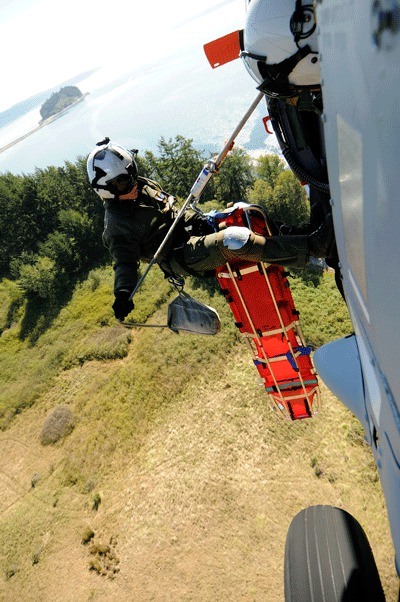Articulate, smart, motivated. The group gathered around the conference room table exude a sense of capability and calm. These are people you would love to share a cup of coffee with, or invite home to meet your mom.
However, they are not ones who you want to meet during their work day.
Encountering them most likely means that something has gone terribly wrong and you are in danger of losing life, limb or sight in a remote, wilderness location.
It is the intrepid hikers, climbers, back-country skiers and outdoor enthusiasts who count on the skills of the Naval Air Station Whidbey Island Search and Rescue teams when they get into a jam. The crew aboard the Navy’s chopper pulls the injured from the craggy mounts and sheer cliffs of northwest Washington — from places where few even venture to tread.
“We are a last resort,” pilot Lt. Leah Tunnell said.
The people needing rescue have the experience to be out in these remote locations, said AWS1 Dennis Grieco, but a fall or equipment failure can lead to them needing airborne rescue. Grieco said he remembers a rescue of a National Outdoor Leadership School instructor — the best of the best when it comes to knowing outdoor skills.
The Navy’s Search and Rescue responds when other rescue agencies request its help and where a land-based operation is difficult, if not impossible to perform. Requests are routed through the Air Force Rescue Coordination Center and then through the air station’s leadership.
Grieco adds that they also assist when a rescue operation could put a ground crew in danger.
Since last October, the air station’s search and rescue has performed a total of 17 missions, four medevacs, seven rescues and six searches.
The organization provides medevac services, most regularly from the San Juan islands, when the weather is too dangerous for Airlift Northwest to fly.
In October, they have already been called on twice — including the rescue of a fallen climber from Mount Erie on Fidalgo Island — and they always stand ready should the need arise.
The mission
The Navy’s Search and Rescue’s primary mission, however, is not to rescue injured hikers or climbers. Instead, it is to use their skills to locate a pilot or crew member ejected from a malfunctioning or damaged jet. As area residents well know, the jet pilots from the Naval Air Station must practice a large number of operations prior to carrier-based deployments.
On the nights the jets fly, the helicopter team preps so they are ready to leave in under 15 minutes.
The group says saving lives makes the them feel great — and it also develops their skills.
The Pacific Crest Trail
On Sept. 10, a Navy Search and Rescue team composed of five members, Lt. Cmdr. Fred Morrison, Lt. Dylan Beyer, AWS1 Brian Casey, AWS1 Dennis Grieco and HM2 Brent McIntyre pulled a hiker to safety and medical care after he had fallen 10 feet.
The hiker had almost completed his five-month, 2,650 mile trek on the Pacific Crest Trail, an arduous trail with significant elevation changes that zigzags from Mexico to Canada through California, Oregon and Washington.
Countless steps brought the hiker within miles of his destination and a wife waiting for him at the trail’s completion. Each year, an average of 300 hikers attempt this trail in one long, continuous hike.
Instead, calamity struck as the trail gave way under the hiker’s seasoned feet and he fell, breaking his ankle in three places.
Isolated and alone, the hiker activated a spot locator — a beacon to let authorities know that he needed help and his location.
The device was really accurate, Tunnell said. She was able to direct the chopper to within 100 feet of the coordinates the device had provided.
“I am sure he was pretty disappointed (he didn’t make it all the way),” AWS1 Brian Casey said. “But he was in good spirits and very thankful.”
Mount Torment
Two days earlier, a Navy SAR team composed of AWS2 Will Rush, HM2 Alex Nguyen, Tunnell, Grieco, and Beyer rescued a climber from the remote Mount Torment, located about 65 miles into the Cascades. The climber had fallen 100 feet onto a rock on the south face of the mountain. Two climbers contacted a park ranger to alert authorities of the accident.
For 15 minutes, the man had remained unconscious and unresponsive. It was also believed that he had sustained internal injuries and damage to his left arm and shoulder.
The fallen climber was stuck for about eight hours on the mountain before the Navy received the call at 5:30 p.m. With the sun slipping behind the mountains, time was of the essence to extract the injured man from the 7,600 foot elevation, they said.
“What we are first told about the injuries is often wildly off,” Nguyen said.
But in this case, the injuries the man had sustained were on the mark. What was not correct was the location. The initial latitude and longitude coordinates did not match up with the glacial formation that the team had been told to look for.
Luckily, good communication with the park ranger on the ground and visual cues led the team to locate the man and extract him for transport and medical treatment.
Within 45 minutes of the helicopter launching from NAS Whidbey, the man was inside the chopper and on his way to the hospital.
“We always follow-up with our patients a day or two after a mission to make sure they are doing okay,” said McIntyre. “It is the best job in the Navy.”



